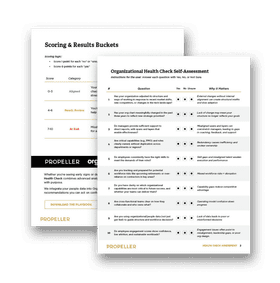Experts estimate that more than a third of large organizations are in the midst of a transformation program, especially as they adapt to the changes AI is bringing to their industries. While transformation is essential to remain competitive, it can also introduce risks of duplication, inefficiencies, and confusion around new business workstreams and individual roles and responsibilities. If left unaddressed, misalignments can hinder long-term performance—slowing projects, contributing to employee disengagement, and leaving companies trailing behind the competition.
Even when organizational structures are assessed during the annual strategic planning process, leaders often lack a clear path forward once misalignment is identified. This is where an organizational health check adds value. It turns observation into action.
An organizational health check is a powerful tool that unlocks the full potential of your organization by diagnosing how well your strategy and operating model are reflected in your organizational structures. At Propeller, our tech-enabled, human-centered process pairs workforce data with insights gained from on-the-ground interviews and document reviews. We examine data around org functions to deliver visualizations that can highlight talent gaps and risks, expose spans and layers challenges, or validate the need for realignment. With this mix of quantitative and qualitative insight, leaders gain clarity on friction points and can plan more effectively and move forward.
The following symptoms are indicators that it’s time for an organizational health check.
# From Stalled to Strategic: A Health Check in Action
Because not every organizational challenge is a structural one, organizational health checks help identify the right area for action (or sometimes inaction). In many cases, a health check can keep transformation projects aligned with organizational goals. This was true for one multi-brand retailer that had implemented a new operating model to increase agility in adapting to changing consumer preferences and reduce its time to market.
To achieve this goal, the retailer engaged Propeller to provide change management support for the new model. We conducted an organizational health check using qualitative and quantitative insights gathered via employee survey. Feedback revealed a key barrier: the organization lacked the technology and processes required to achieve its goals. Rather than focusing on organizational structure, we discovered the retailer needed to standardize processes across departments and implement technology that would enable cross-functional collaboration. Without the health check, leadership would have directed resources toward efforts misaligned with the organization’s actual needs.


10 Signs Your Organization is Experiencing Symptoms of Misalignment
An organizational health check brings your workforce data together, allowing leaders to visualize how teams are equipped to deliver on organizational goals—and, when benchmarking is appropriate, how you compare to competitors. At its most effective, this data is infused with context from employee feedback, leadership interviews, and documented processes. This nuance helps organizations move forward in line with their unique culture.
A health check is especially valuable during transformation planning or following a period of significant growth.
Here are 10 signs it might be time for you to conduct a health check:
Has your structure evolved in response to growth or change? When external conditions such as market forces, supply chains, and rapid technological evolution occur, organizations can drift away from strategic intent. Likewise, geographic expansion, acquisitions, and product innovation can challenge your existing structure in supporting future growth.
Do you have clarity on which capabilities are critical to future success? An organizational health check can help determine whether teams are equipped to deliver on your goals. A clear understanding of your differentiating capabilities ensures you’re investing in areas that maximize impact.
Have changes in organizational structure been informed by a clear understanding of business impact? Realigning without visibility into costs or consequences can erode value. Whether you’re changing team structure, headcount, or operating model, you should know exactly what costs will be required to deliver against key performance indicators. An organizational health check can bring together the data that empowers confident, strategic transformation.
Is top talent being placed in the most critical roles? Misaligned talent can lead to underperformance and disengagement, especially in high-stakes functions. A health check can integrate performance data to identify high-potential individuals—and help develop a plan to keep them engaged.
Is our organization prepared for future workforce risks? Understanding workforce demographics and composition can improve long-term planning. For example, organizations can use retirement age and tenure data to guide timely succession planning. The right data helps teams determine the optimal mix of contractors and full-time employees, guiding decisions on when to outsource tasks or bring critical expertise back in-house.
Are you exploring new ways to do more with less? From outsourcing to automation, leaders are exploring ways to boost productivity without adding to their headcount. Each of these changes impacts the skill sets needed in-house and shapes organizational structure. Additionally, many organizations will need to consider how to account for AI as a teammate within their organizational structure. For example, your structure may account for a strategic creative lead, with certain roles beneath that individual housed and owned by AI.
Is your span of control too flat or too deep? A health check can reveal top-heaviness, bottlenecks, or under-leveraged teams. Data can help organizations improve workforce planning and develop a timeline for better balancing the number of direct reports to each manager, helping unlock employee growth.
Does the work across teams happen seamlessly? Many organizations struggle with unclear responsibilities, shadow teams, or duplicate activities. An org health check can use data to identify skill gaps and redundancies. It can also provide insight into the best practices around talent management that keep some departments running smoothly when others consistently hit roadblocks.
Have you performed an organizational health check within the past three years? In 2022, Gartner reported that the average employee would experience 10 enterprise change initiatives that year. With that volume of change, a health check helps validate whether investments across people, process, data, and technology fit the organization.
Are you making strategic decisions based on data or gut instinct? A health check helps ensure you’re validating intuition with actionable insight.
# Align With Purpose, Lead With Confidence
Even high-performing teams drift without structural alignment. Recognizing the signs of misalignment can help you build a strategy to get back on track.
Propeller’s Organizational Health Check delivers both the insight and support needed to realign with purpose. Our human-centered, tech-enabled perspective balances workforce data with strategic interpretation and qualitative insights.
If you’re experiencing symptoms of misalignment—or preparing for your next transformation—reach out to learn more about how our rapid Organizational Health Check can help you refocus and advance.

Take the Org Health Check Quiz
Uncover hidden misalignment and see where your organization stands with our quick Org Health Check Quiz.






